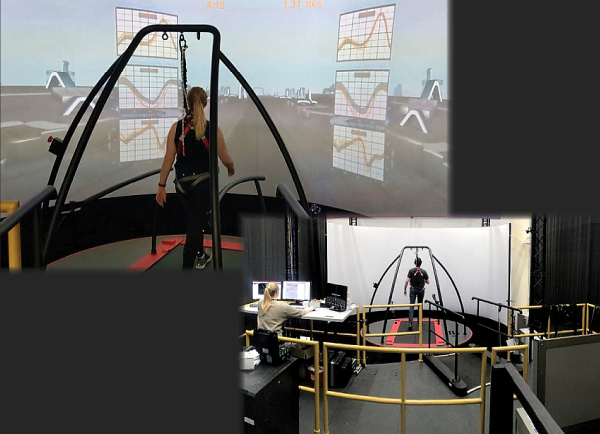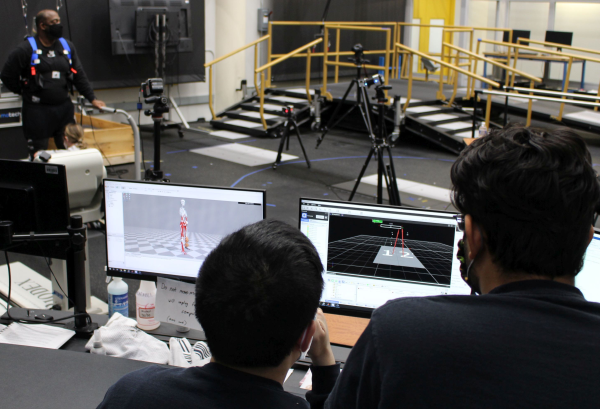Facility Overview
The Human Augmentation Core Facility is a ~ 3000 square foot space in the Callaway Building with two main human subject research bays: The Motek CAREN system bay and the Gait Lab bay. Additionally, a private patient changing room is equipped with a hi-lo plinth and sink for preparation of subjects prior to and following experiments. Wearable robotic devices intended to augment the hip, knee and ankle are available in portable or tethered capabilities.
Additional physiological measurement systems available for use during human subject experiments include metabolic consumption analysis tools(Parvo/COSMED), EMG/IMU systems (Delsys/Biometrics) and Ultrasound (Telemed/SonixTouch). These tools allow for improved understanding of the physiological processes occurring during ambulation and other functional tasks.

Motek CAREN System
The Motek CAREN system is an integrated virtual reality environment for rehabilitation purposes. The system includes a Stuart platform (6 DOF) robot which can provide rotations and translations of the treadmill to simulate different perturbations, terrains and environments. The CAREN system comes equipped with a surround screen to help the human subject feel like they are in various environments, such as a city, boat, mountain or uneven terrain. The integrated motion capture allows syncing between the environment, human user, and treadmill motion. The CAREN features a split belt treadmill with 6-DOF force plates under each belt for inverse dynamics.

Gait Lab Bay
The Gait Lab Bay is equipped with a split-belt force instrumented treadmill with incline/decline functionality and two additional treadmills including a normal human treadmill with incline and an extra-large, high-speed (35 mph) treadmill for additional collection capabilities. The gait lab space also features a straight line walking path with 18 possible force plate locations and adjustable step length capability and a turning path configuration with an additional 14 force plate locations also with adjustable step length capability. An additional straight line walking path is equipped with a 16’ gait mat capable of rapid collection and processing of various gait spatiotemporal parameters.
The Gait Lab Bay additionally contains a novel terrain park with a ramp and 2 stairsets (a 6 step and 5 step staircase) custom designed to simulate a broad range of various terrains in the lab with full capability to collect human biomechanics including force plate and motion capture data. The terrain park moves on a hydraulic lift to allow for the 16’ ramp to move from ADA levels (<3°) to a steep 18° ramp incline. The ramp has bilateral force plates at the top, middle, bottom and first level-walking step on the platform. The stairs also adjust height corresponding to the height of the platform to allow for a wide variety of stairs heights and are instrumented with force plates on each step. The gait lab has a 32-camera Vicon motion capture system to surround both the terrain park, level walking force plates and force treadmill to get full coverage of kinematic data to sync with the force plates. Additionally, an overhead harness system supports the terrain park and treadmill to provide subject safety during walking.





